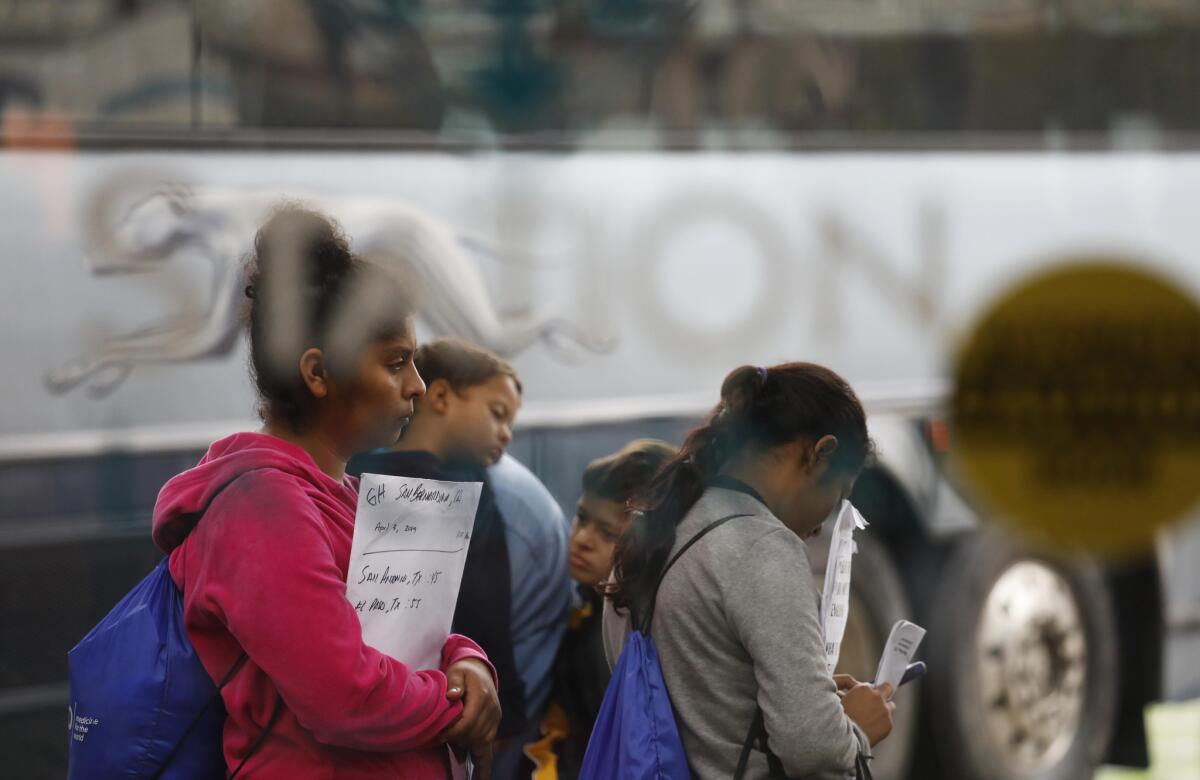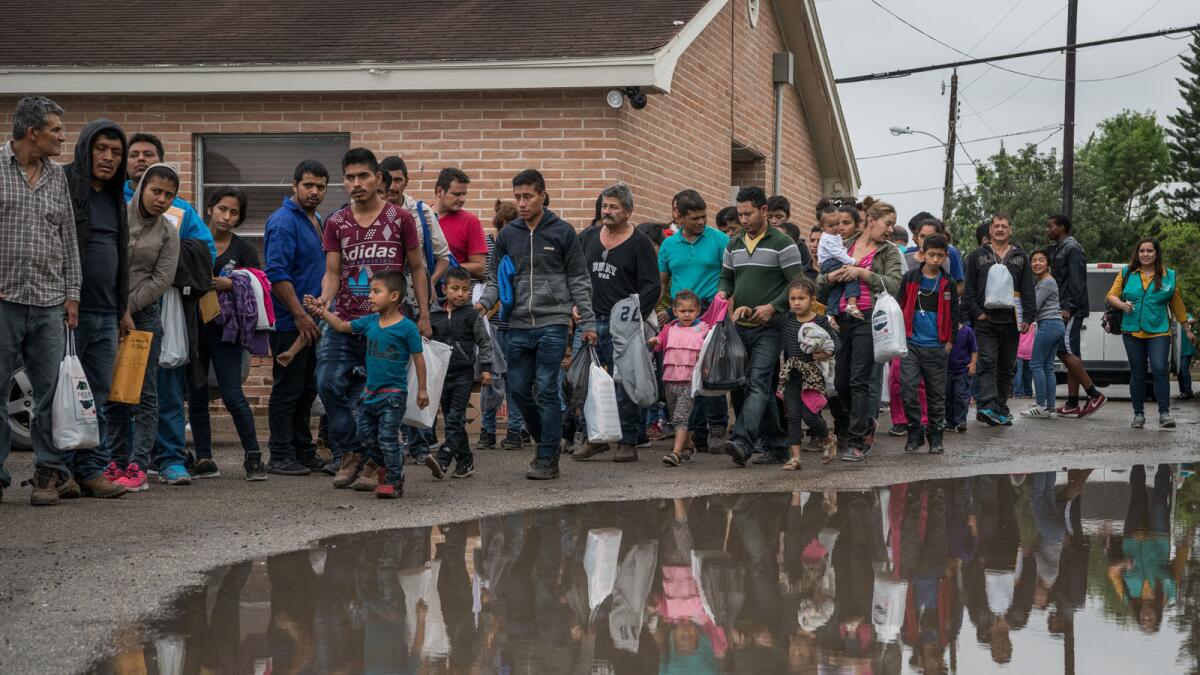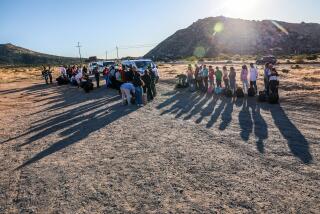Border Patrol’s largest holding area — known to migrants as ‘the kennel’ — is overwhelmed

Reporting from McAllen, Texas — Overwhelmed by an influx of migrant families, the federal government’s largest holding facility for people caught crossing the border illegally has run out of space and exhausted its budget.
The Central Processing Center, located in McAllen, Texas, is known to migrants as la perrera, or “the kennel.” Designed for 1,500 people, it now houses 2,400, according to Border Patrol officials, who gave journalists a rare tour on Wednesday.
Men slept shoulder to shoulder on concrete floors under a sea of mylar blankets. Children wailed as they waited behind chain-link barriers to use portable bathrooms and showers. Single adults had to wait to be driven to showers in another building. Sick parents and children rested on mats behind a partition.
The Border Patrol has already spent its $12.5-million operating budget for the facility for the fiscal year that started in October. Officials have requested an additional $12.5 million to cover staffing, food and other supplies for the rest of the year.
The agency showed off the crowded facility before President Trump visits the California border town of Calexico on Friday, hoping to convince the public that the country is facing a national emergency that requires stepped-up enforcement, including a border wall that Congress has refused to authorize.
Homeland Security Secretary Kirstjen Nielsen visited El Paso Border Patrol facilities Wednesday and was due to visit those in Yuma, Ariz., on Thursday.
Both areas have seen sharp increases in migrant families arriving this year. El Paso’s holding facilities were 280% over capacity this week, with more than 3,400 people in custody, some held under a bridge and in tents.

In the Rio Grande Valley, the busiest stretch of border for illicit crossings, agents have caught about 1,000 migrants a day for roughly the last two weeks. The number traveling in families has climbed 200% compared with this time last year, said Carmen Qualia, an assistant chief patrol agent who runs the facility.
“They’re crossing with very little items because they know this facility exists,” Qualia said as she led reporters past cells packed with migrant parents and children. “They know if they come as a family they will have a clear path through. This is a policy crisis.”
Smaller holding areas at Border Patrol stations throughout the Rio Grande Valley were also packed. Officials said 6,000 migrants — including 527 unaccompanied children — were crammed into stations built for a total of 3,363.
In recent weeks, the Border Patrol has attempted to ease the overcrowding by releasing thousands of migrant families from the McAllen center and other holding areas with notices to appear in immigration court, rather than transferring them to Immigration and Customs Enforcement family detention centers, which are also full.
U.S. border authorities hold migrant families in a pen under an El Paso bridge »
Critics of illegal migration have condemned the practice as a return to the “catch and release” policies Trump had vowed to stop.
Migrant advocates have scrambled to house, feed and transport the hundreds of family members released daily in the Rio Grande Valley and El Paso, which has also seen an influx of families arriving on the border this year.
A total of 750 customs officers have been reassigned from entry ports in El Paso, Tucson, San Diego and Laredo, Texas, to assist Border Patrol with processing migrants; more than half of those were sent to help the McAllen facility’s staff of 120.
A few National Guard troops from Texas were also assisting here. Federal Emergency Management Agency officials toured the center Wednesday and are expected to help the Border Patrol erect tents or other temporary holding areas at stations across the Rio Grande Valley, Qualia said.
During Wednesday’s tour, reporters were not allowed to interview, photograph or record migrants or Central American consular officials meeting with them. Qualia and other Border Patrol agents answered questions as they led the group through an outdoor sally port where migrants waited in line with children to be processed.
Inside, agents could be seen questioning migrant men and capturing their fingerprints using an electronic device. Men in neighboring cells shouted that they were hungry.
Agents said the migrants received hot meals, snacks, clothes, laundry service and medical care at an on-site clinic. They stay an average 50 to 60 hours, Qualia said.
The Border Patrol recently added more portable bathrooms and intends to expand the number of showers from the current total of 36, which can only accommodate 500 to 600 people a day.
About three dozen small children huddled together in one of the chain-link cells below a television screen showing the movie “Smallfoot.” In a cell nearby, men huddled with babies in their arms. About half of children arriving with a parent here come with a father, a dramatic increase from years past, Qualia said.
About half are what she called “fraudulent family units” — a child traveling with a relative posing as a parent. As part of processing, agents check documents such as birth certificates, some of which have proved to be fake.
Trump administration moves to close offices for international asylum and refugee cases »
Some children even reappear at the facility with different adults, “recycled” by smugglers, although the Border Patrol has a policy of not checking biometrics of children under age 14, so it’s difficult to track how many, Qualia said.
She said migrants who arrive seeking asylum have already heard about the center in their home countries and expect to be released to local shelters. U.S. court decisions have limited the federal government’s ability to detain families to 20 days.
“They’re here because they know we cannot hold them,” she said.
The center, which was built in 2014 to house large groups of unaccompanied minors, has long drawn criticism from migrant advocates and lawmakers, who consider its chain-link fenced cells inhumane and unhealthy, even when they’re not packed.
But it’s a model the Border Patrol is expanding: The agency is expected to open a similar, $192-million processing center in El Paso this summer.
More to Read
Sign up for Essential California
The most important California stories and recommendations in your inbox every morning.
You may occasionally receive promotional content from the Los Angeles Times.











